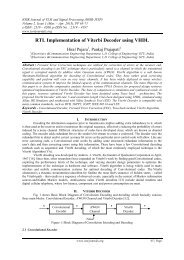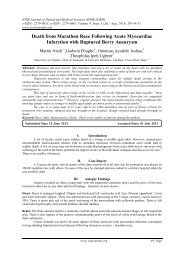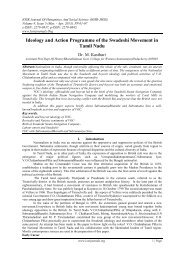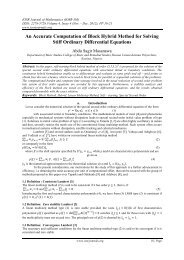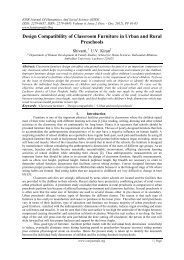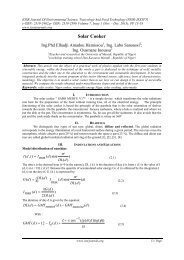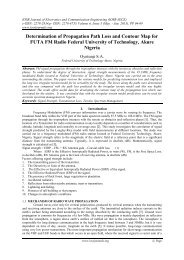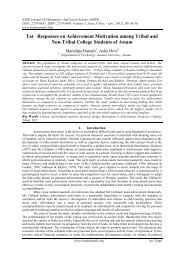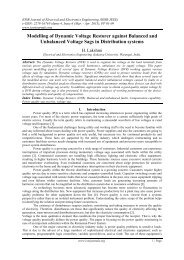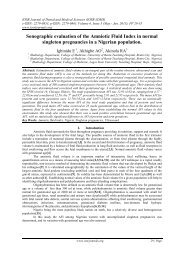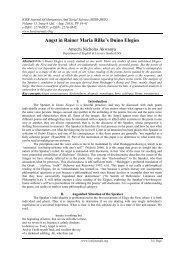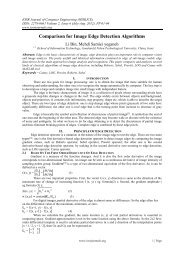Initial Conquest of India by Turks and Their Slaves - IOSR
Initial Conquest of India by Turks and Their Slaves - IOSR
Initial Conquest of India by Turks and Their Slaves - IOSR
Create successful ePaper yourself
Turn your PDF publications into a flip-book with our unique Google optimized e-Paper software.
<strong>Initial</strong> <strong>Conquest</strong> Of <strong>India</strong> By <strong>Turks</strong> And <strong>Their</strong> <strong>Slaves</strong><br />
Hind‟), „Shah-i-Sharq‟, („King <strong>of</strong> the East‟) (at his death in 1236) <strong>and</strong> „Saltan Saltatin ash-sharq‟, („The Sultan<br />
<strong>of</strong> the Sultans <strong>of</strong> the East‟). The latter title occurs with Iltutmish for the first time, as does the title<br />
„Shahanshah‟,(„King <strong>of</strong> Kings‟), which had been associated with the emperors <strong>of</strong> Persia. Iltutmish was the first<br />
ruler is <strong>India</strong> to receive sanction for his rule from the Abbaside Caliph in Baghgad whose emissaries he received<br />
on 22nd Rabi, I, 626/19th February 1229. He introduced a new coinage system which remained essentially the<br />
same up to 1387; the silver tanka <strong>of</strong> one tola weight (172 gm) <strong>and</strong> the copper jital, distinct from Delhiwalas as<br />
well as the fractional coins <strong>of</strong> copper. Shamsuddin Iltutmish died on 20 Shaban 633/29 April 1236 <strong>of</strong> an illness<br />
contracted during his expedition to the northwest. He took up Aibaks unfinished work <strong>and</strong> against heavy odds<br />
<strong>and</strong> on imperfect foundation, built up a state whose sovereignty required great diplomatic skill to presence. A<br />
calculating <strong>and</strong> skill full organizer, to him the sultanate owed the first outline <strong>of</strong> its administrative system. Aibak<br />
outlined the Delhi Sultanate <strong>and</strong> its sovereign status; Iltutmish was unquestionably its first king who made the<br />
kingship hereditary for his children.<br />
The Ghurid annexation <strong>of</strong> <strong>India</strong>n territories was not merely for loot <strong>and</strong> plunder as their predecessors<br />
had done before, but the Ghurid conquest <strong>of</strong> <strong>India</strong> was done with proper planning, as it increased their wealth<br />
<strong>and</strong> also they do not let the conquered territories to slip out <strong>of</strong> there h<strong>and</strong>s. They do not conquered the rural<br />
areas as they were less important <strong>and</strong> having less wealth within them. The Ghurid conquered the much<br />
important towns, cities <strong>and</strong> the places having some strategic position whether laying on a trade route, nearness<br />
to some important town or city,places <strong>of</strong> military importance like Hansi,Kuhram,Sarsuti or a place from where<br />
the Ghurids found it easy to conquer the other areas like Baran,Meerut became the spearheads <strong>of</strong> attack from the<br />
north on the Gahadvala dominions.<br />
By following this strategy they annexed the most important areas <strong>of</strong> Dar-ul-Harab or Hindustan as<br />
muslims called it <strong>and</strong> they developed them more <strong>and</strong> more,the towns got developed into cities,cities into<br />
metropolitans,headquarters got developed into provincial headquarters etc. <strong>and</strong> thus the urbanism developed in<br />
<strong>India</strong> with the muslim conquest.<br />
I. Endnotes<br />
H.Escedy,‟Tribe <strong>and</strong> Tribal Society in the 6 th Century Empire‟,Acta Orientalia Hungarica,25 (1972);<br />
P.B.Golden,‟ „Imperial Ideology <strong>and</strong> the Sources <strong>of</strong> Political Unity amongst the Pre-Cinggisid Nomads <strong>of</strong><br />
Western Eurasia‟, Archivum Eurasiae Medii Aevi,II (1982),pp.39-62; idem,History <strong>of</strong> the Turkic Peoples,<br />
pp.115-53.<br />
H.H<strong>of</strong>fmann,‟Die Qarluq in der Tibetaischen Literatur‟,Oriens,III,2 (1950),pp.190-208.Cf.Wink,<br />
Andre,Al-Hind,The Making <strong>of</strong> the Indo-Islamic World,Vol. II,The Slave Kings <strong>and</strong> The Islamic <strong>Conquest</strong> 11th-<br />
13th cen.,Oxford University Press(1999),p.60.[Hereafter Al-Hind,II]<br />
G.Clauson,Turkish <strong>and</strong> Mongolian Studies(London,1962),p.1-3,6,11,14.<br />
Ibid,p.8-9,11.<br />
Al Biruni,Kitab fi Tahqiqi mali-I-Hind (Hyderabad,<strong>India</strong>,1958),p.16[Hereafter Al Biruni,Kitab al-Hind]<br />
Definitions <strong>of</strong> Central Asia vary a great deal with different scholars,as do those <strong>of</strong> Inner Asia.<br />
A.M.Khazanor, for instance, refers Central Asia merely as the area which is flanked in the north <strong>by</strong> the Aral Sea<br />
<strong>and</strong> the Kazakh steppes, in the south <strong>by</strong> the Kopet-Dagh <strong>and</strong> Hindukush, in the west <strong>by</strong> the Caspian Sea, <strong>and</strong> in<br />
the east <strong>by</strong> the Pamirs‟ (Nomads <strong>and</strong> Oases in Central Asia; in J.A. Hall <strong>and</strong> I.C. Jarvie (eds), Transition to<br />
Modernity: Essays on Power, Wealth <strong>and</strong> Belief (Cambridge,1992),p.69). In Sinor (ed)., The Cambridge History<br />
<strong>of</strong> Early Inner Asia (Cambridge,1990). On the other h<strong>and</strong>, there is the concept <strong>of</strong> Inner Asia, which is equated<br />
with the Central Eurasia, <strong>and</strong> both <strong>of</strong> these are defined as cultural rather than geographical concepts; thus, the<br />
boundaries <strong>of</strong> this area fluctuated because the essential historical feature <strong>of</strong> Central Eurasia/Inner Asia, as Sinor<br />
sees it, is that its socities were usually characterized predominantly <strong>by</strong> pastoral nomadism rather than sedentary<br />
agriculture. In this conception, Seljuq – Turkish Anatolia in the eleventh century,for example, becomes part <strong>of</strong><br />
Inner Asia in so far as nomads displace a Byzantine agricultural peasantry. Muta is mut<strong>and</strong>is, this should apply<br />
to Iran in the thirteenth century as well.<br />
L.Kwanten, Imperial Nomads: a History <strong>of</strong> Central Asia,500-1500(Philadelphia,1979),p.20, 32; C.I.<br />
Beckwith, „Aspects <strong>of</strong> the Early History <strong>of</strong> the Central Asian Guard Corps in Islam’,Archivum Eurasia.Medii<br />
Aevi,IV(1984), p.32; Golden,P.B.’Imperial Ideology <strong>and</strong> the Sources <strong>of</strong> Political Unity amongst the Pre-<br />
Cinggisid Nomads <strong>of</strong> Western Eurasia’,Archivum Eurasiae Medii Aevi.II (1982),p.42-43; Codrington,K.de.B.,„A<br />
Geographical Introduction to the history <strong>of</strong> Central Asia’,The Geographical Journal,CIV (1944),p.86.<br />
This definition <strong>of</strong> an ethnic community is proposed <strong>by</strong> A.D.Smith, The Ethnic Origins <strong>of</strong><br />
Nations(Oxford,1986),p.32 <strong>and</strong> adopted for the <strong>Turks</strong> <strong>by</strong> Golden,P.B.,An Introduction to the History <strong>of</strong> Turkic<br />
Peoples: Ethnogenesis <strong>and</strong> State formation in Medieval <strong>and</strong> Early Modern Eurasia <strong>and</strong> the Middle East<br />
(Wiesbaden,1992),p.1-2.Such community does not need to be able to refer to a common biological descent; in<br />
fact,they are always „polyethnic‟ <strong>and</strong> political in character, with members who were born into it as well as<br />
www.iosrjournals.org<br />
7 | Page



